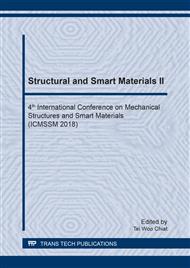p.3
p.8
p.14
p.20
p.26
p.34
p.43
p.48
Effect of Laser Shock Peening on Surface Residual Stress and Plastically Affected Depth of TC11 Titanium Alloy
Abstract:
The confined laser shock peening (LSP) is an innovative surface treatment technique designed to improve the fatigue performance of materials by imparting compressive residual stresses into materials. A 3D finite element model was developed to predict the surface residual stress and plastically affected depth of the TC11 titanium alloy after LSP. The modeling procedure consists of two successive explicit analysis steps. The performance of finite element model was verified by comparing simulated results with the experimental data. With the validated finite element model, the influence of the process parameters (LSP path, thickness of the sample, number of impacts) was investigated on the surface residual stress and plastically affected depth of the TC11 titanium alloy after LSP. Some simulated results can be used to mentor the optimization of the process parameters of LSP.
Info:
Periodical:
Pages:
20-25
Citation:
Online since:
January 2019
Authors:
Price:
Сopyright:
© 2019 Trans Tech Publications Ltd. All Rights Reserved
Share:
Citation:


